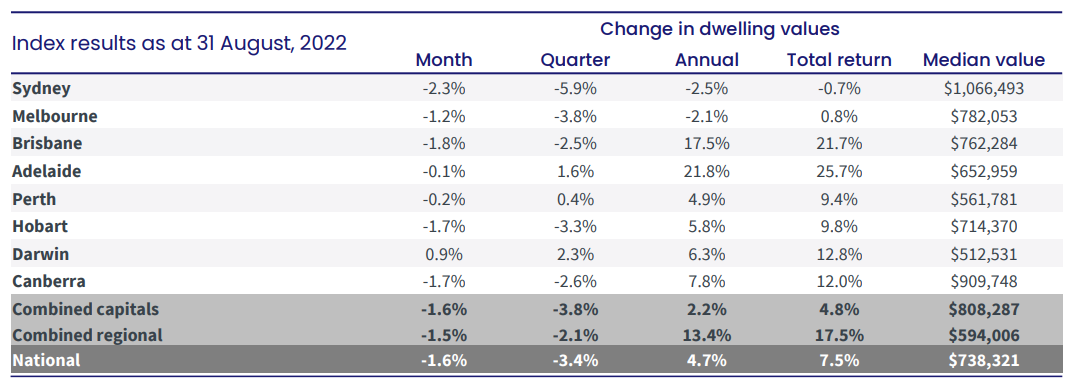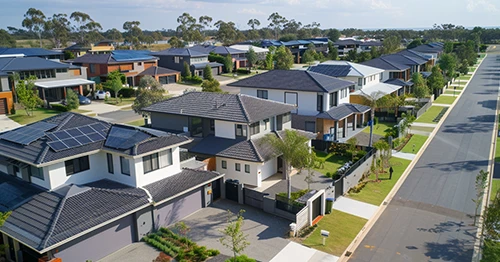Updated: 26 Dec, 2024
CoreLogic’s Home Value Index recorded a fourth straight monthly decline in August 2022, falling 1.6%. This is the largest month-on-month decline since 1983.
Every capital city except for Darwin experienced a housing downturn. Sydney led the downswing, its values fell 2.3%, but Brisbane’s downturn accelerated rapidly.
“It was only two months ago that the Brisbane housing market peaked after recording a 42.7% boom in values,” CoreLogic research director Tim Lawless said. “Over the past two months, the market has reversed sharply, with values down -1.8% in August after a -0.8% drop in July.”
Regional Australia Also In Decline
The fall in regional dwelling values has caught up with that of capital cities. Regional home values were down 1.5% in August 2022, almost even with the 1.6% for combined capitals. Regional dwelling values had experienced a stronger appreciation during the upswing; they rose by 40%, compared with 25.5% for combined capitals.
The largest falls for regional values came in commutable lifestyle hubs where housing prices had increased before the cash rate hikes. Over the past three months to August 2022, values fell 8% across Richmond-Tweed, 4.8% across Southern Highlands-Shoalhaven and 4.5% across Queensland’s Sunshine coast.
Of the 41 regional sub-regions analysed, only seven experienced a rise in housing values. These included Adelaide’s northern suburbs (0.9%), Perth’s North East (0.6) and Mandurah (0.5%), and the Coffs Harbour-Grafton region (0.6).
Property Market Highlights
Here’s what happened to the Australian property market in August 2022.
- The annual growth rate across combined capitals eased to 2.2% after a peak of 21.3% in November 2021.
- Housing values in most capital cities and regions are still at least 15% above the levels recorded in March 2020. This means most homeowners are not at risk of negative equity, as they should still have a significant equity buffer.
- The amount of freshly advertised housing stock added to capital city markets over the four weeks ending 28 August 2022 was 13.4% more than during the same period a year ago and 6.5% above the five-year average. There are currently 11.3% more homes available for sale than at this time last year.
- The higher advertised stock levels were the result of low demand, rather than a rise in the number of listings added to the market. Across the country, CoreLogic estimates there were 14.8% fewer home sales over the three months to August than during the same period last year. Larger declines were posted in Sydney, Canberra and Melbourne, where sales were down 35.4%, 18.9% and 16.5%, respectively.
- Rents increased 0.8% in August across CoreLogic’s national rental index. However, they eased from the peak increase of 1% in May. The slowdown in rental appreciation was most evident across regional Australia, where the annual rate of rent growth eased from 12.5% in November 2021 to 10.1% over the 12 months ending August 2022. In the combined capital cities, the monthly trend dipped to 1% in August, from a peak of 1.1% in May 2022.
- The rental growth slowdown has been more evident for houses than units. Over the past five years, house rents across combined capitals have increased by 21.8%, compared with 10.8% for units; however, in many areas – especially in Melbourne and Sydney – unit rents are now rising much faster, as tenants are becoming more willing to rent in higher-density situations due to expensive rents on houses.
- Gross rental yields improved. After capital city gross dwelling yields dropped to a record low of 2.96% in February 2022, they rose to 3.29% in August 2022. Even though capital city yields are below the pre-COVID-19 decade average of 4%, rental yields could return to average levels next year, if housing prices continue falling while rents keep going up rapidly, as forecasters predict.
Housing Market Outlook For Spring 2022
The housing market outlook is tethered to the trajectory of interest rates. There are forecasts that the cash rate could go up to 4%. Lawless explains, “As borrowing power is eroded by higher interest rates and rising household expenses due to inflation, it’s reasonable to expect a further decline in consumer confidence and lower housing demand.”
There could be some improvement in housing affordability. In the recent ANZ CoreLogic Housing Affordability report, the decline in housing values decreased the time needed to save a 20% deposit across capital cities for the first time in two years. However, the portion of annual income required to service a new mortgage increased to 44% in June 2022, from 40.4% in March 2022.
With spring approaching, advertised stock levels are expected to rise. Advertised supply could accumulate through spring due to a lack of demand. Lawless explains, “Amid higher advertised stock levels, vendors will be competing across a larger pool of available supply for fewer buyers. While this is positive news for buyers, sellers will need to be realistic in their pricing expectations.”
The risks of distressed listings, forced sales and mortgage stress are minimised due to momentum in income growth and the high serviceability buffers.








